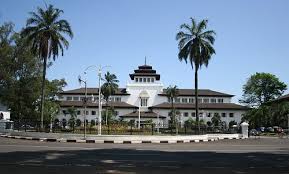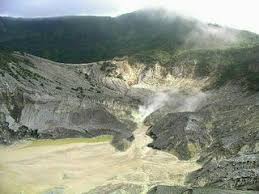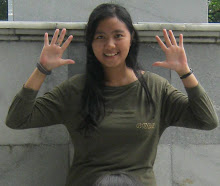If it see from cable's hook at main span, the bridge is included in Harp type. So because the tipping point locations is scattered, not at one point at top of the span like the fan type.
If it see from number and shape of cable's hook at two sides of span which is asymmetric (West part:2*5=10, East part 1*9=9), So the bridge is classified as Asymmetrical Harp type.
Sate Building
 Gedung Sate Bandung is the first building that uses concrete bony construction, is also building institutions of governance Dutch Colonial Center. Called Gedung Sate, the roof-shaped ornaments thrust sate. Now, this building became the center pemerintahah Governor of West Java. It is one of the landmark buildings of Bandung and has become an icon for the city. Designed and built in 1920, by architect J. Gerber.
Gedung Sate Bandung is the first building that uses concrete bony construction, is also building institutions of governance Dutch Colonial Center. Called Gedung Sate, the roof-shaped ornaments thrust sate. Now, this building became the center pemerintahah Governor of West Java. It is one of the landmark buildings of Bandung and has become an icon for the city. Designed and built in 1920, by architect J. Gerber.
Building on the north, there is a field Gasibu and People's Struggle Monument. Area Gasibu People's Struggle Monument and will look very busy on Sunday, because in the two locations near this always be a place for sport in the morning. In addition to use as sports facilities, both locations are often used as places of music, art and culture and other activities.
Angklung (Traditional Instrumental)
 Angklung is the musical instrument originated from Indonesia, angklung is used and played by the Sundanese since the ancient times. In Hindu period and Padjajaran kingdom era, Sundanese people used the angklung to sign the time for prayer. Later, Padjajaran kingdom use this instrument as corps music in Bubat War (versus Majapahit kingdom). Angklung functioned as building the peoples community spirit. It was still used by the Sundanese until the colonial Dutch East Indies (V.O.C) era. Because of the colonial times, the Dutch East Indies government tried to forbid people playing the angklung instrument.
Angklung is the musical instrument originated from Indonesia, angklung is used and played by the Sundanese since the ancient times. In Hindu period and Padjajaran kingdom era, Sundanese people used the angklung to sign the time for prayer. Later, Padjajaran kingdom use this instrument as corps music in Bubat War (versus Majapahit kingdom). Angklung functioned as building the peoples community spirit. It was still used by the Sundanese until the colonial Dutch East Indies (V.O.C) era. Because of the colonial times, the Dutch East Indies government tried to forbid people playing the angklung instrument.
Tangkuban Parahu Volcano
 Tangkuban perahu is a volcano, 25 kilometers north of Bandung direction of Lembang. Its location is in between Sagalaherang village, Sagalaherang district, Subang regency and Cikole village, Lembang district, Bandung regency. This is Bandung's most famous tourist volcano just 28 km north of the city. This volcano offers many places to see and explore. Whether we look into the huge crater or hike down into it, stroll through the forest on its slopes, or simply enjoy the splendid panoramic scenery. Mt. Tangkuban Perahu is an interesting destination that everyone in the Bandung area is fond of visiting. When seen from Bandung, Mt. Tangkuban Perahu has a distinctive shape, like an upside down boat. Tangkuban Perahu means, in fact, "up-turned boat" This peculiar shape has stimulated the fantasy of the Sundanese people from early times as expressed in the Legend of Sangkuriang.
Tangkuban perahu is a volcano, 25 kilometers north of Bandung direction of Lembang. Its location is in between Sagalaherang village, Sagalaherang district, Subang regency and Cikole village, Lembang district, Bandung regency. This is Bandung's most famous tourist volcano just 28 km north of the city. This volcano offers many places to see and explore. Whether we look into the huge crater or hike down into it, stroll through the forest on its slopes, or simply enjoy the splendid panoramic scenery. Mt. Tangkuban Perahu is an interesting destination that everyone in the Bandung area is fond of visiting. When seen from Bandung, Mt. Tangkuban Perahu has a distinctive shape, like an upside down boat. Tangkuban Perahu means, in fact, "up-turned boat" This peculiar shape has stimulated the fantasy of the Sundanese people from early times as expressed in the Legend of Sangkuriang.
Building on the north, there is a field Gasibu and People's Struggle Monument. Area Gasibu People's Struggle Monument and will look very busy on Sunday, because in the two locations near this always be a place for sport in the morning. In addition to use as sports facilities, both locations are often used as places of music, art and culture and other activities.
Gedung Sate literally means 'Satay Building'. The name is a reference to the metal spike on the roof which reminded Iocals of a satay skewer. For anyone interested in architecture, it is one of the most unmissable sights in Java. It was an innovative design in 1920 for a number of reasons. It was the first building in Indonesia to use reinforced concrete technology. Artistically, it was even more significant. It was one of the first buildings to combine Indonesian and European styles of architecture to create the 'Indo-Deutsch' style. It has a tiered, wooden roof, like a Javanese mosque. The main motif on the front of the building is a stylised Javanese temple. The extensive use of dark timber for the roofing is a conscious reference to local architectural styles. Yet the brilliant white of the main structure with its bold arches mark it out as very much a Dutch building. Gedung Sate is impressive in both its huge scale and also in its attention to small details. The window niches and the wooden eaves both feature beautiful and intricate decoration. Any lover of architecture should not miss this building.
Angklung made out of two bamboo tubes attached to a bamboo frame. The tubes are carved so that they have a resonant pitch when struck. The two tubes are tuned to octaves. The base of the frame is held with one hand while the other hand shakes the instrument rapidly from side to side. This causes a rapidly repeating note to sound. Thus each of three or more angklung performers in an ensemble will play just one note and together complete melodies are produced. Angklung is popular throughout Southeast Asia.
The Angklung got more international attentionand respect when Daeng Soetigna, from Bandung West Java, expanded the angklung notations not only to play traditional pelog or slendro scales, but also diatonic scale in 1938. Since then, angklung is often played together with other western music instruments in an orchestra. One of the first well-known performances of angklung in an orchestra was during the Bandung Conference in 1955. A few years later, Udjo Ngalagena, a student of Daeng Soetigna, opened his Saung Angklung (House of Angklung) in 1966 as centre of its development.





0 comments:
Posting Komentar